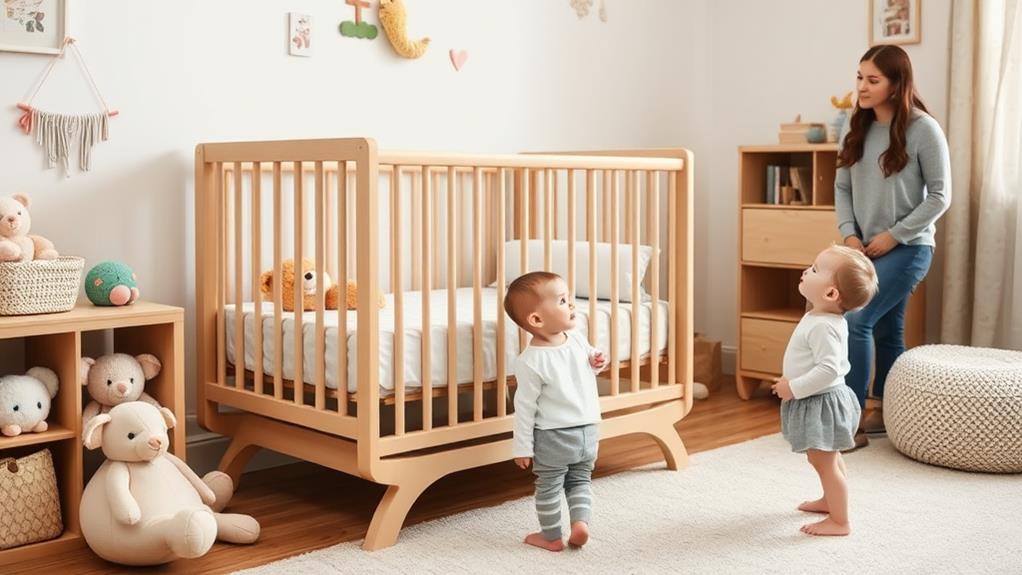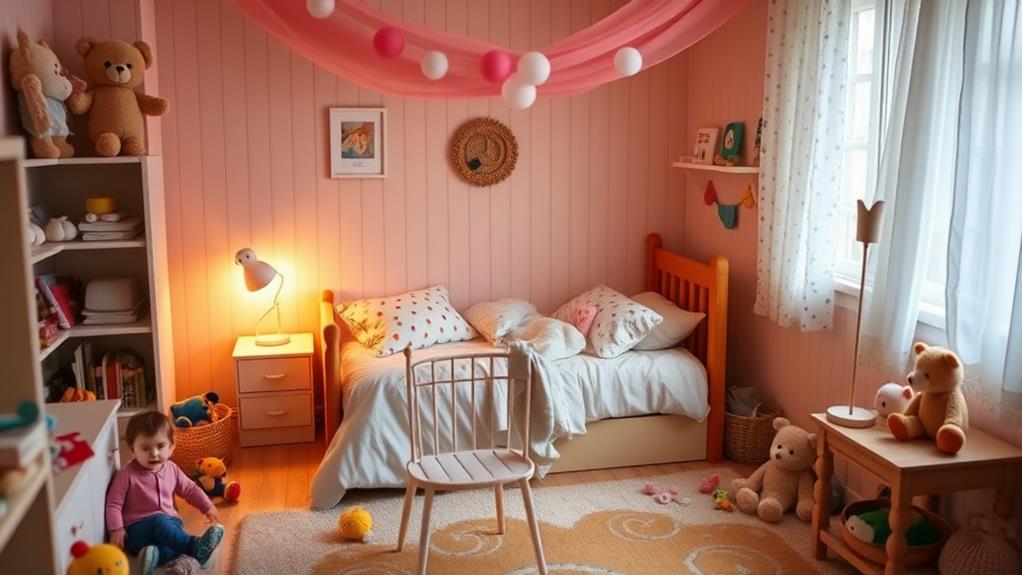If you've noticed your toddler starting to climb out of the crib, you know how concerning it can be. It's crucial to take steps to ensure their safety while also promoting good sleep habits. By assessing the crib height and using sleep sacks, you can significantly reduce the chances of escape. Establishing a consistent bedtime routine and creating a safe sleep environment are equally important. But what should you do when your little one shows signs of readiness for a toddler bed? Let's explore some practical strategies to keep them safe and secure.
Assess the Crib Height

When it comes to keeping your toddler safe, assessing the crib height is crucial. You want to make sure your little one isn't at risk of climbing out or falling.
Start by checking the height of the crib mattress. Most cribs have adjustable mattress heights, which can be lowered as your child grows. For infants, the mattress should be at its highest setting, making it easier for you to lift them in and out.
As your toddler becomes more mobile, consider lowering the mattress to the middle or lowest position. This simple adjustment can significantly reduce the chances of them climbing out.
Remember, the top rail of the crib should be at least 26 inches above the mattress for safety.
Also, keep an eye on your child's height and physical development. If they can easily reach over the rail, it might be time to make changes.
If you're worried about your toddler's safety, it's better to be proactive. Regularly assess the crib height to ensure it meets their growing needs.
After all, a safe sleeping environment is essential for both you and your little one!
Use Sleep Sacks
Lowering the crib mattress can help prevent your toddler from climbing out, but another effective strategy is using sleep sacks. Sleep sacks are wearable blankets that keep your toddler cozy and secure while they sleep. By using a sleep sack, you limit your toddler's ability to move freely, making it more difficult for them to climb out of the crib.
When selecting a sleep sack, look for one that fits snugly but isn't too tight. This way, your child can't easily wiggle out of it. Opt for a sleep sack made of breathable fabric, ensuring your little one stays comfortable throughout the night.
Sleep sacks come in various sizes and styles, so you're likely to find one that suits your toddler's preferences.
Using a sleep sack during bedtime can also promote a sense of security. Your toddler might feel snug and safe, which can help them settle down for a good night's sleep.
Plus, as they get used to the sleep sack, they may develop a sleep association with it, making bedtime easier for everyone.
Establish a Bedtime Routine

Creating a consistent bedtime routine can significantly help prevent your toddler from climbing out of the crib. A predictable series of activities signals to your child that it's time to wind down.
Start with a calming activity, like reading a story or singing a lullaby. These moments not only soothe your child but also create a bond that helps them feel secure.
Next, establish a specific time for bed. Consistency is key, so try to keep this time the same each night. This helps your toddler understand that bedtime is non-negotiable.
Additionally, you might consider a visual schedule to make the routine more engaging. Simple pictures can guide them through each step, making bedtime feel like a fun adventure rather than a chore.
As you move through the routine, keep the atmosphere calm and quiet. Dim the lights and minimize loud noises to encourage relaxation.
Create a Safe Sleep Environment
To ensure your toddler stays safe while sleeping, you need to create an environment that minimizes risks and distractions. Start by removing any items from the crib that could help them climb out, like toys or blankets. A bare crib is the safest option, as it eliminates potential hazards.
Next, check the crib's mattress height. If your toddler is getting close to the top, lower the mattress to make it harder for them to climb.
Also, make sure the crib is sturdy and meets safety standards; this helps prevent any wobbling that could encourage adventurous climbing.
Consider using a fitted sheet that's snug and free of excess fabric, as loose bedding can be a tripping hazard.
Additionally, keep the room dimly lit during sleep hours. A nightlight can provide a sense of comfort without being too distracting.
Transition to a Toddler Bed

Making the switch to a toddler bed can be an exciting milestone for both you and your little one. It's a sign of growing independence and a chance for your child to embrace their new sleeping space.
Start by choosing a bed that's low to the ground, making it easy for your toddler to get in and out safely. You might want to involve your child in the selection process. Letting them pick out bedding or a special stuffed animal can make the transition feel more special.
Before the big move, set clear expectations. Explain what a toddler bed means and how it differs from a crib.
When the time comes, create a calm bedtime routine to ease the adjustment. This might include reading a story, dimming the lights, or playing soft music.
You should also ensure the room is safe. Remove any hazards that could lead to accidents.
